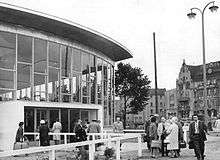Tränenpalast

The Tränenpalast (English: "Palace of Tears") is the Berlin colloquialism for the former border crossing at Berlin Friedrichstraße station, where East Germans said goodbye to visitors going back to West Germany. From 1962 to 1989 it was the border crossing for travellers by S-bahn, U-bahn and train between East and West Germany. It was used only for westbound border crossings, with separate checkpoints for West Berliners, West Germans, foreigners, diplomats, transit travellers and East Germans.
The term Tränenpalast derives from the tearful goodbyes that took place in front of the building, where western visitors had to say farewell to East Germans that were not permitted to travel to West Berlin.[1][2]
Border station during the time of the Berlin Wall

Although the Berlin Friedrichstraße station was located entirely in the Soviet sector of Berlin, because of the Berlin Wall some S-bahn and U-bahn lines were accessible only from West Berlin. West Berlin travellers could use the station to transfer between those lines, or to cross into East Germany. The Tränenpalast was built after the volume of traffic and the constraints of the lower level of the main building made it necessary to expand.[1][2][3]
After the fall of the Berlin Wall
After the fall of the Berlin Wall, the building was used as a nightclub and stage until 2006.[4] It has been a listed building since October 2nd, 1990. One day before the official unification of the former East and West Germany, the GDR government had several official buildings listed as there was uncertainty about what would happen to them after the German reunification.[5] The Tränenpalast is a unique symbol of the diverse fates of people on both sides of the border during the German separation. Whether arriving in or leaving East Berlin, travellers came to expect harsh, stressful encounters with border guards. Friends and families never knew if they would see each other again.
Exhibition
In 2008 the Tränenpalast was included in the expanded federal memorial site concept.[5] On 15 September 2011, the Stiftung Haus der Geschichte opened a permanent exhibition to remind visitors of the consequences and daily restrictions due to the German separation. On 550 square metres, original artefacts, documents, photographs and audio and video recordings show the experiences at the checkpoint and give an overview of the reunification process. [6]
It was opened by Chancellor Merkel on 14 September 2011. In the first two weeks more than 30,000 people visited Tränenpalast; entrance is free.
Gallery
During the Cold War
 Entrance to the Tränenpalast.
Entrance to the Tränenpalast.
During the Fall of the Berlin Wall
 Custom checks by East German officers on those exiting East Berlin
Custom checks by East German officers on those exiting East Berlin Passport stamp of the border crossing Friedrichstrasse.
Passport stamp of the border crossing Friedrichstrasse.
Post German Reunification
 Construction near the Tränenpalast in 2008.
Construction near the Tränenpalast in 2008.
See also
References
| Wikimedia Commons has media related to Tränenpalast. |
- 1 2 "Chronicle of the Berlin Wall" (in German). Chronik-der-mauer.de.
- 1 2 "Former border station Friedrichstraße" (in German). Berlin.de.
- ↑ "Stadtschnellbahn Berlin" (in German). Stadtschnellbahn-berlin.de.
- ↑ Official website (German)
- 1 2 "Geschichte des Tränenpalasts im Überblick". Website of the Haus der Geschichte der Bundesrepublik Deutschland Foundation (German)
- ↑ Official website of the Tränenpalast
External links
Coordinates: 52°31′15″N 13°23′13″E / 52.5208°N 13.3869°E
